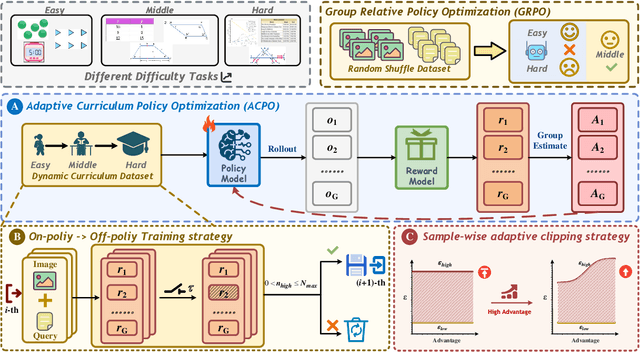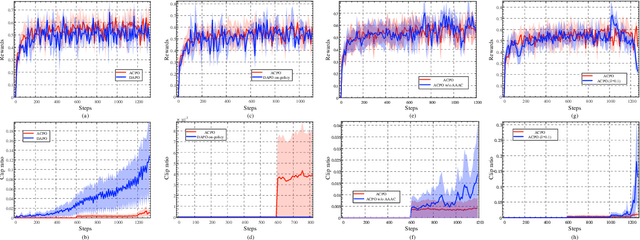Shuai Chen
for the ALFA study
ACPO: Adaptive Curriculum Policy Optimization for Aligning Vision-Language Models in Complex Reasoning
Oct 01, 2025



Abstract:Aligning large-scale vision-language models (VLMs) for complex reasoning via reinforcement learning is often hampered by the limitations of existing policy optimization algorithms, such as static training schedules and the rigid, uniform clipping mechanism in Proximal Policy Optimization (PPO). In this work, we introduce Adaptive Curriculum Policy Optimization (ACPO), a novel framework that addresses these challenges through a dual-component adaptive learning strategy. First, ACPO employs a dynamic curriculum that orchestrates a principled transition from a stable, near on-policy exploration phase to an efficient, off-policy exploitation phase by progressively increasing sample reuse. Second, we propose an Advantage-Aware Adaptive Clipping (AAAC) mechanism that replaces the fixed clipping hyperparameter with dynamic, sample-wise bounds modulated by the normalized advantage of each token. This allows for more granular and robust policy updates, enabling larger gradients for high-potential samples while safeguarding against destructive ones. We conduct extensive experiments on a suite of challenging multimodal reasoning benchmarks, including MathVista, LogicVista, and MMMU-Pro. Results demonstrate that ACPO consistently outperforms strong baselines such as DAPO and PAPO, achieving state-of-the-art performance, accelerated convergence, and superior training stability.
RISK: A Framework for GUI Agents in E-commerce Risk Management
Sep 26, 2025Abstract:E-commerce risk management requires aggregating diverse, deeply embedded web data through multi-step, stateful interactions, which traditional scraping methods and most existing Graphical User Interface (GUI) agents cannot handle. These agents are typically limited to single-step tasks and lack the ability to manage dynamic, interactive content critical for effective risk assessment. To address this challenge, we introduce RISK, a novel framework designed to build and deploy GUI agents for this domain. RISK integrates three components: (1) RISK-Data, a dataset of 8,492 single-step and 2,386 multi-step interaction trajectories, collected through a high-fidelity browser framework and a meticulous data curation process; (2) RISK-Bench, a benchmark with 802 single-step and 320 multi-step trajectories across three difficulty levels for standardized evaluation; and (3) RISK-R1, a R1-style reinforcement fine-tuning framework considering four aspects: (i) Output Format: Updated format reward to enhance output syntactic correctness and task comprehension, (ii) Single-step Level: Stepwise accuracy reward to provide granular feedback during early training stages, (iii) Multi-step Level: Process reweight to emphasize critical later steps in interaction sequences, and (iv) Task Level: Level reweight to focus on tasks of varying difficulty. Experiments show that RISK-R1 outperforms existing baselines, achieving a 6.8% improvement in offline single-step and an 8.8% improvement in offline multi-step. Moreover, it attains a top task success rate of 70.5% in online evaluation. RISK provides a scalable, domain-specific solution for automating complex web interactions, advancing the state of the art in e-commerce risk management.
CMP: A Composable Meta Prompt for SAM-Based Cross-Domain Few-Shot Segmentation
Jul 22, 2025Abstract:Cross-Domain Few-Shot Segmentation (CD-FSS) remains challenging due to limited data and domain shifts. Recent foundation models like the Segment Anything Model (SAM) have shown remarkable zero-shot generalization capability in general segmentation tasks, making it a promising solution for few-shot scenarios. However, adapting SAM to CD-FSS faces two critical challenges: reliance on manual prompt and limited cross-domain ability. Therefore, we propose the Composable Meta-Prompt (CMP) framework that introduces three key modules: (i) the Reference Complement and Transformation (RCT) module for semantic expansion, (ii) the Composable Meta-Prompt Generation (CMPG) module for automated meta-prompt synthesis, and (iii) the Frequency-Aware Interaction (FAI) module for domain discrepancy mitigation. Evaluations across four cross-domain datasets demonstrate CMP's state-of-the-art performance, achieving 71.8\% and 74.5\% mIoU in 1-shot and 5-shot scenarios respectively.
DFR: A Decompose-Fuse-Reconstruct Framework for Multi-Modal Few-Shot Segmentation
Jul 22, 2025Abstract:This paper presents DFR (Decompose, Fuse and Reconstruct), a novel framework that addresses the fundamental challenge of effectively utilizing multi-modal guidance in few-shot segmentation (FSS). While existing approaches primarily rely on visual support samples or textual descriptions, their single or dual-modal paradigms limit exploitation of rich perceptual information available in real-world scenarios. To overcome this limitation, the proposed approach leverages the Segment Anything Model (SAM) to systematically integrate visual, textual, and audio modalities for enhanced semantic understanding. The DFR framework introduces three key innovations: 1) Multi-modal Decompose: a hierarchical decomposition scheme that extracts visual region proposals via SAM, expands textual semantics into fine-grained descriptors, and processes audio features for contextual enrichment; 2) Multi-modal Contrastive Fuse: a fusion strategy employing contrastive learning to maintain consistency across visual, textual, and audio modalities while enabling dynamic semantic interactions between foreground and background features; 3) Dual-path Reconstruct: an adaptive integration mechanism combining semantic guidance from tri-modal fused tokens with geometric cues from multi-modal location priors. Extensive experiments across visual, textual, and audio modalities under both synthetic and real settings demonstrate DFR's substantial performance improvements over state-of-the-art methods.
CMaP-SAM: Contraction Mapping Prior for SAM-driven Few-shot Segmentation
Apr 07, 2025



Abstract:Few-shot segmentation (FSS) aims to segment new classes using few annotated images. While recent FSS methods have shown considerable improvements by leveraging Segment Anything Model (SAM), they face two critical limitations: insufficient utilization of structural correlations in query images, and significant information loss when converting continuous position priors to discrete point prompts. To address these challenges, we propose CMaP-SAM, a novel framework that introduces contraction mapping theory to optimize position priors for SAM-driven few-shot segmentation. CMaP-SAM consists of three key components: (1) a contraction mapping module that formulates position prior optimization as a Banach contraction mapping with convergence guarantees. This module iteratively refines position priors through pixel-wise structural similarity, generating a converged prior that preserves both semantic guidance from reference images and structural correlations in query images; (2) an adaptive distribution alignment module bridging continuous priors with SAM's binary mask prompt encoder; and (3) a foreground-background decoupled refinement architecture producing accurate final segmentation masks. Extensive experiments demonstrate CMaP-SAM's effectiveness, achieving state-of-the-art performance with 71.1 mIoU on PASCAL-$5^i$ and 56.1 on COCO-$20^i$ datasets.
EvoP: Robust LLM Inference via Evolutionary Pruning
Feb 19, 2025



Abstract:Large Language Models (LLMs) have achieved remarkable success in natural language processing tasks, but their massive size and computational demands hinder their deployment in resource-constrained environments. Existing structured pruning methods address this issue by removing redundant structures (e.g., elements, channels, layers) from the model. However, these methods employ a heuristic pruning strategy, which leads to suboptimal performance. Besides, they also ignore the data characteristics when pruning the model. To overcome these limitations, we propose EvoP, an evolutionary pruning framework for robust LLM inference. EvoP first presents a cluster-based calibration dataset sampling (CCDS) strategy for creating a more diverse calibration dataset. EvoP then introduces an evolutionary pruning pattern searching (EPPS) method to find the optimal pruning pattern. Compared to existing structured pruning techniques, EvoP achieves the best performance while maintaining the best efficiency. Experiments across different LLMs and different downstream tasks validate the effectiveness of the proposed EvoP, making it a practical and scalable solution for deploying LLMs in real-world applications.
RadioLLM: Introducing Large Language Model into Cognitive Radio via Hybrid Prompt and Token Reprogrammings
Jan 28, 2025



Abstract:The increasing scarcity of spectrum resources and the rapid growth of wireless device have made efficient management of radio networks a critical challenge. Cognitive Radio Technology (CRT), when integrated with deep learning (DL), offers promising solutions for tasks such as radio signal classification (RSC), signal denoising, and spectrum allocation. However, existing DL-based CRT frameworks are often task-specific and lack scalability to diverse real-world scenarios. Meanwhile, Large Language Models (LLMs) have demonstrated exceptional generalization capabilities across multiple domains, making them a potential candidate for advancing CRT technologies. In this paper, we introduce RadioLLM, a novel framework that incorporates Hybrid Prompt and Token Reprogramming (HPTR) and a Frequency Attuned Fusion (FAF) module to enhance LLMs for CRT tasks. HPTR enables the integration of radio signal features with expert knowledge, while FAF improves the modeling of high-frequency features critical for precise signal processing. These innovations allow RadioLLM to handle diverse CRT tasks, bridging the gap between LLMs and traditional signal processing methods. Extensive empirical studies on multiple benchmark datasets demonstrate that the proposed RadioLLM achieves superior performance over current baselines.
Retrieval-Augmented Generation by Evidence Retroactivity in LLMs
Jan 07, 2025Abstract:Retrieval-augmented generation has gained significant attention due to its ability to integrate relevant external knowledge, enhancing the accuracy and reliability of the LLMs' responses. Most of the existing methods apply a dynamic multiple retrieval-generating process, to address multi-hop complex questions by decomposing them into sub-problems. However, these methods rely on an unidirectional forward reasoning paradigm, where errors from insufficient reasoning steps or inherent flaws in current retrieval systems are irreversible, potentially derailing the entire reasoning chain. For the first time, this work introduces Retroactive Retrieval-Augmented Generation (RetroRAG), a novel framework to build a retroactive reasoning paradigm. RetroRAG revises and updates the evidence, redirecting the reasoning chain to the correct direction. RetroRAG constructs an evidence-collation-discovery framework to search, generate, and refine credible evidence. It synthesizes inferential evidence related to the key entities in the question from the existing source knowledge and formulates search queries to uncover additional information. As new evidence is found, RetroRAG continually updates and organizes this information, enhancing its ability to locate further necessary evidence. Paired with an Answerer to generate and evaluate outputs, RetroRAG is capable of refining its reasoning process iteratively until a reliable answer is obtained. Empirical evaluations show that RetroRAG significantly outperforms existing methods.
Intent-Enhanced Data Augmentation for Sequential Recommendation
Oct 11, 2024



Abstract:The research on intent-enhanced sequential recommendation algorithms focuses on how to better mine dynamic user intent based on user behavior data for sequential recommendation tasks. Various data augmentation methods are widely applied in current sequential recommendation algorithms, effectively enhancing the ability to capture user intent. However, these widely used data augmentation methods often rely on a large amount of random sampling, which can introduce excessive noise into the training data, blur user intent, and thus negatively affect recommendation performance. Additionally, these methods have limited approaches to utilizing augmented data, failing to fully leverage the augmented samples. We propose an intent-enhanced data augmentation method for sequential recommendation(\textbf{IESRec}), which constructs positive and negative samples based on user behavior sequences through intent-segment insertion. On one hand, the generated positive samples are mixed with the original training data, and they are trained together to improve recommendation performance. On the other hand, the generated positive and negative samples are used to build a contrastive loss function, enhancing recommendation performance through self-supervised training. Finally, the main recommendation task is jointly trained with the contrastive learning loss minimization task. Experiments on three real-world datasets validate the effectiveness of our IESRec model.
GSLoc: Efficient Camera Pose Refinement via 3D Gaussian Splatting
Aug 20, 2024



Abstract:We leverage 3D Gaussian Splatting (3DGS) as a scene representation and propose a novel test-time camera pose refinement framework, GSLoc. This framework enhances the localization accuracy of state-of-the-art absolute pose regression and scene coordinate regression methods. The 3DGS model renders high-quality synthetic images and depth maps to facilitate the establishment of 2D-3D correspondences. GSLoc obviates the need for training feature extractors or descriptors by operating directly on RGB images, utilizing the 3D vision foundation model, MASt3R, for precise 2D matching. To improve the robustness of our model in challenging outdoor environments, we incorporate an exposure-adaptive module within the 3DGS framework. Consequently, GSLoc enables efficient pose refinement given a single RGB query and a coarse initial pose estimation. Our proposed approach surpasses leading NeRF-based optimization methods in both accuracy and runtime across indoor and outdoor visual localization benchmarks, achieving state-of-the-art accuracy on two indoor datasets.
 Add to Chrome
Add to Chrome Add to Firefox
Add to Firefox Add to Edge
Add to Edge